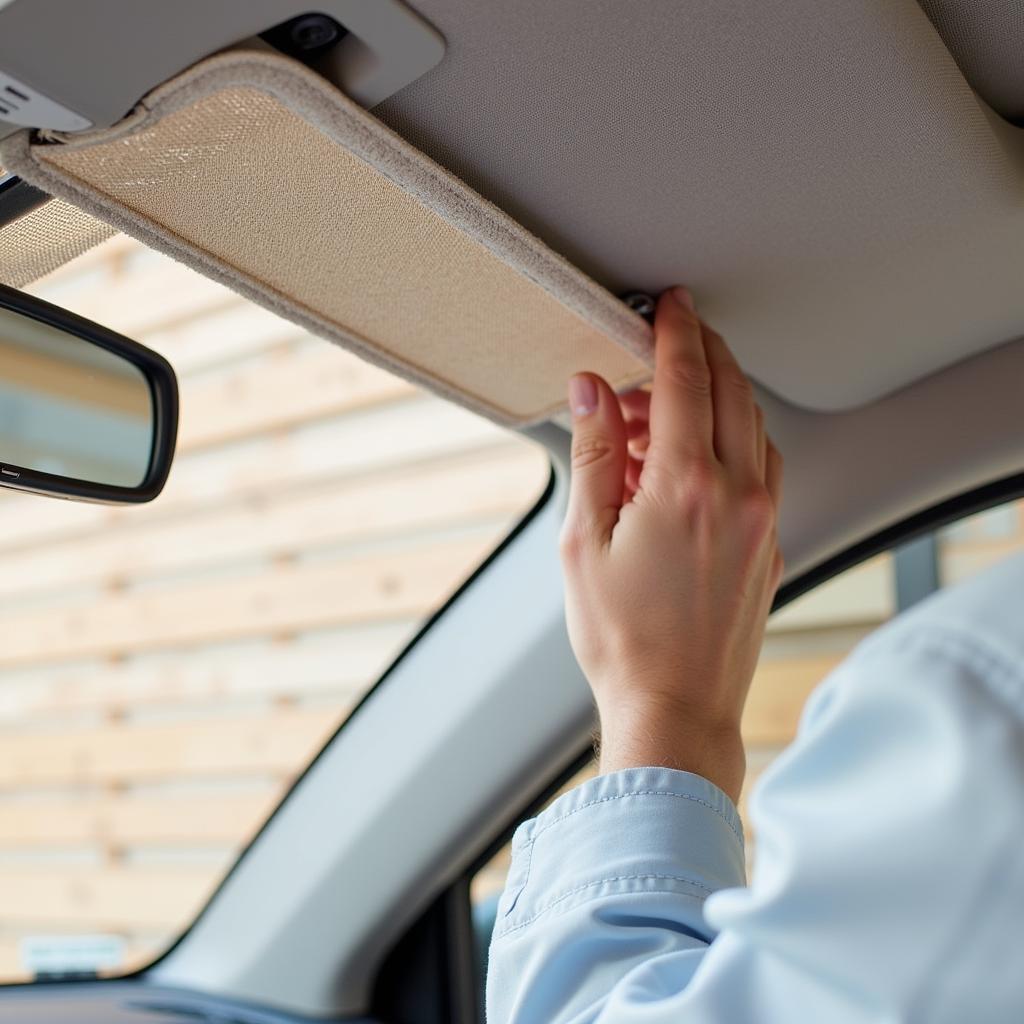A sagging car ceiling, also known as a headliner, is an annoying problem that can affect the aesthetics and safety of your vehicle. Luckily, you can usually fix a sagging car ceiling yourself with a few basic tools and materials. This comprehensive guide will walk you through the causes, solutions, and preventive measures for a drooping car liner.
Why is My Car Ceiling Sagging?
Before we dive into the solution, let’s understand the reasons behind a sagging car ceiling.
- Failing Adhesive: Over time, the adhesive used to bond the headliner fabric to the backing board can deteriorate due to heat, humidity, or moisture.
- Old Age: Like any other component in your car, the headliner has a lifespan. Continuous exposure to heat and sunlight can make the fabric brittle and prone to sagging.
- Improper Installation: If you’ve recently had your windshield replaced or any work done on your car’s roof, improper installation might be the culprit.
- Moisture Damage: Leaks in your car’s roof, be it from a damaged sunroof seal or a cracked windshield, can seep into the headliner and cause the adhesive to fail.
How to Fix a Sagging Car Ceiling
Fixing a sagging car ceiling doesn’t necessarily require a trip to the mechanic. Here’s a step-by-step guide for a DIY fix:
Materials You’ll Need:
- Upholstery adhesive (spray or brush-on)
- Cleaning cloth or sponge
- Scissors
- Straight pins or clothespins
- Utility knife (optional)
- Small paint roller (optional)
Steps:
- Identify the Cause: Before you begin, pinpoint the reason for the sagging. Check for water damage, loose fabric, or adhesive failure.
- Prepare the Area: Remove any obstructions like sun visors, interior lights, or trim pieces that might hinder access to the headliner.
- Clean the Headliner: Use a cleaning cloth dampened with a mild cleaner to clean the area where the fabric has detached from the backing board. Allow it to dry thoroughly.
- Apply the Adhesive: Following the manufacturer’s instructions, apply the upholstery adhesive to both the back of the fabric and the backing board. If you’re using spray adhesive, ensure adequate ventilation.
- Reattach the Fabric: Carefully press the fabric back onto the board, smoothing it out from the center to the edges to eliminate any wrinkles or air bubbles. Use straight pins or clothespins around the edges to hold the fabric in place while the adhesive dries.
- Trim Excess Fabric: Once the adhesive has dried, use a utility knife to trim any excess fabric.
- Reinstall Trim Pieces: Reinstall any trim pieces, sun visors, or interior lights that you removed earlier.
 Reattaching Car Ceiling Fabric
Reattaching Car Ceiling Fabric
Tips for a Successful Repair
- Choose the right adhesive: Use a high-quality upholstery adhesive specifically designed for automotive applications. For more comprehensive information on choosing the right adhesive, you can refer to our guide on fixing headliner in a car.
- Work in a well-ventilated area, especially when using spray adhesive.
- For larger areas or stubborn sags, you might need to use a steamer to soften the old adhesive before reattaching the fabric. You can learn more about this in our article on how to fix the ceiling fabric in my car.
- If the headliner is severely damaged or the foam backing is crumbling, consider replacing the entire headliner board.
Preventing Future Sagging
While a DIY fix can effectively address a sagging car ceiling, preventive measures can help you avoid this issue in the long run:
- Regular Cleaning: Keep your car’s interior clean and dry. Wipe down the headliner periodically to prevent dust and dirt buildup.
- Address Leaks Promptly: Any leaks in your car’s roof should be addressed immediately to prevent moisture damage to the headliner.
- Park in the Shade: Whenever possible, park your car in the shade to minimize the damaging effects of UV rays on your car’s interior.
When to Call a Professional
While a DIY approach is often successful, certain situations warrant professional help:
- Extensive Water Damage: If the sagging is due to substantial water damage or mold growth, it’s best to consult a professional.
- Airbag Concerns: If the sagging affects the area around the airbags, seeking professional assistance is crucial to avoid interfering with the airbag deployment.
Conclusion
A sagging car ceiling can be a nuisance, but with a little patience and effort, you can often fix it yourself using the steps outlined in this guide. Remember to address the root cause of the problem and take preventive measures to ensure your car’s interior stays in top shape.
Need further assistance with your car’s interior repairs? Don’t hesitate to contact the experts at AutoTipPro. Give us a call at +1 (641) 206-8880 or visit our office at 500 N St Mary’s St, San Antonio, TX 78205, United States. We’re here to help you get your car back in pristine condition.




Leave a Reply